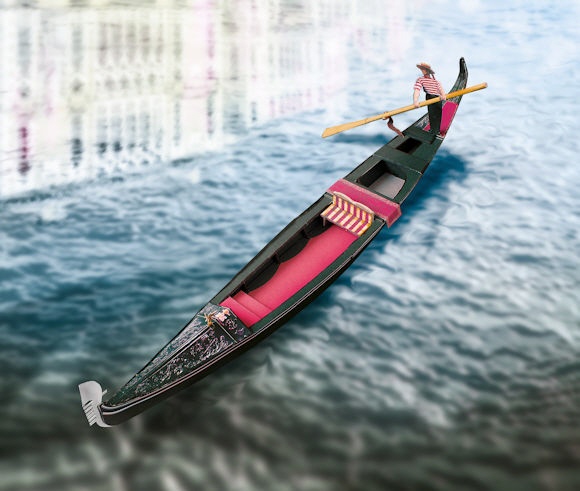Venetian Gondola

scale 1:33
length 35 cm
width 13 cm
height 8 cm
degree of difficulty 2
number of sheets 2.5
Venetian Gondola (1:33)
Gondolas on the canals of Venice were first mentioned in a document in the 11th century. The origin of the word is not quite certain. Possible derivations from Latin or Greek are: “cimbula” (small boat, barque), “concula” (cup), “kondylion” (box) or “kuntò” (float, row, push). The first construction plan for a gondola originates from the 14th century. There was not yet a uniform design, however. Nobles and patricians decorated their gondolas in all shades of colour and with splendid embellishments. However, the Senate and the Church were disturbed by this grandeur and in 1562 they passed a law stipulating that all gondolas had to have the same black colour. Exceptions were only allowed for celebrations and envoys. In the 16th century there were more than 10,000 gondolas in Venice.
From 1882 to 1884 the boat builder Domenico Tramontin developed a construction which is still common to the present day. The most important feature of this construction is a slight shortening of the starboard side. In this way the port side is slightly more curved. As the gondolier stands on the left and rows on the right, the curvature is meant to prevent the boat from moving in a circle. Traditionally, a gondola is constructed from eight different kinds of wood. The black colour is a special mixture that can only be found in Venice. The oarlock is manufactured in special workshops. A gondola consists of 280 individual parts and weighs 400-500 kilograms. The assembly of a gondola takes 500 hours and costs € 13,000 to € 25,000. Carpenters, joiners, locksmiths, ornamental blacksmiths, engravers and upholsterers are involved in the construction. Many shipyards nowadays produce plywood gondolas in order to cut costs. This however means that many traditional workshops see their existence threatened.
As counterweight to the gondolier, a large metal piece is fitted at the bow. It symbolises the City of Venice. The top part resembles the Doge’s cap. The six teeth beneath it represent the six districts of Venice. The tooth pointing to the stern represents the Island of Giudecca. Tradition and symbolism are also very important to the gondoliers. A special municipal law stipulates what clothing they must wear. In summer a gondolier must wear long dark trousers without pockets and a red or blue striped shirt. Even the width of the stripes is stipulated. The band on the gondolier’s straw hat must have the same colour as the shirt. The colours represent three districts each. In addition, a white linen shirt is allowed. Black shoes are obligatory. In winter the gondoliers wear dark clothing and raincoats and bobble caps in the same colour are also allowed. Violations against the dress code are punished by severe fines. Traditionally, the gondoliers are men. In 2007 a German woman fought in court for a licence to steer a gondola, but she is not allowed to use the professional title. In 2010 a woman completed the necessary training and may now officially call herself “Gondoliera”. A gondola ride is a costly affair: 35 minutes without singing cost from € 80 to € 100.
